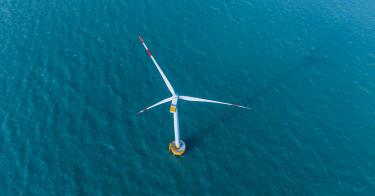Danish wind company Ørsted did New Jersey residents a favor when, despite the state’s tax incentives, it withdrew from its Ocean Wind 1 and 2 offshore-wind projects due to financial difficulties. Democratic Governor Phil Murphy’s offshore-wind plans are not only unsightly—they’d leave residents with an ugly gap in their wallets, amounting to $8,000 per person. Whales and birds also stand to gain if offshore wind abandons the Garden State.
Ørsted’s Ocean Wind 1, a 1,100-megawatt project off the coast of Cape May, would have powered some 500,000 homes, rivaling the output from the Hope Creek nuclear-power station on the Delaware River. After Ocean Wind 1, Murphy planned Ocean Wind 2 with another 1,100 megawatts, aiming for 11,000 megawatts of offshore wind by 2040. The two projects have now been cancelled by the company.
But New Jersey residents cannot yet breathe a sigh of relief. Atlantic Shores Offshore Wind, a partnership between Shell New Energies U.S. LLC and EDF Renewables North America, plans another wind farm off the coast of Atlantic City. This wind farm, which would generate 1,500 gigawatts and power 700,000 homes by 2028, has not yet been cancelled, and it would place hundreds of turbines nine miles from New Jersey’s beaches.
Both Atlantic Shores and Ørsted requested permission to harm whales, dolphins, and porpoises in their project applications. The Ørsted application states, “Proposed activities, as outlined in Section 1.0, have the potential to impact marine mammals within the Project Area from sounds generated by survey equipment.”
>>> U.K.’s Onshore Wind Scheme Could Backfire, With Far More Potent Greenhouse Gas Emissions
Barbara McCall, a board member of the nonprofit Protect Our Coast NJ that opposes New Jersey offshore wind, told me that “offshore-wind proposals don’t recognize the interests of coastal communities, tourism, real-estate values, and recreational and commercial fishing—and there is no mitigation to compensate these affected groups.” With coastal tourism bringing in half the revenues of all tourism in the Garden State, the damage would extend beyond the coast to state revenues.
Atlantic Shores, which is facing challenges posed by inflation, high interest rates, and supply-chain disruptions (all problems that contributed to Ørsted’s withdrawal), is talking to New Jersey’s government about ways to continue operating. In plain English, that means the company is requesting tax incentives, which it currently does not have. And with Ørsted’s departure, Governor Murphy may be open to asking the state legislature for tax breaks for Atlantic Shores.
This would be problematic, not only due to the extra burden on New Jersey residents, but also because Atlantic Shores is foreign-owned. One partner, Shell New Energies, is owned by Royal Dutch Shell PLC, and EDF Renewables is owned by Électricité de France. State tax credits are designed for domestic companies.
Ørsted’s problems are not unique to New Jersey. The Wall Street Journal calculated that, over the past two months, at least ten offshore projects in America and Europe have been postponed or cancelled, totaling $33 billion in spending. The causes are the same—rising costs and interest rates, supply bottlenecks, and local opposition.
The argument for offshore wind is that it lowers fossil-fuel emissions and reduces global warming. Yet the government’s climate models show that, even if New Jersey got rid of all fossil fuels, the reduction in global temperatures would only be 0.0003 degrees Celsius by 2050 and 0.0007 degrees Celsius by 2100, as Heritage Foundation Chief Statistician Kevin Dayaratna found using an Intergovernmental Panel on Climate Change climate-simulator model.
>>> Slavery Poisons Solar Industry’s Supply Chains
If America stopped using fossil fuels today, the effect on global temperatures in the year 2100 would be two-tenths of one degree centigrade, according to calculations by Dr. Dayaratna, based on government models.
Offshore wind in New Jersey costs over $6.75 million per megawatt, according to the Energy Information Administration. If Governor Murphy installed all his planned wind projects, New Jersey residents would pay $74 billion for 11,000 megawatts of offshore wind, or $8,000 per resident, with no meaningful reduction in global temperatures.
Reliance on wind power raises costs of electricity because the wind does not always blow, and each wind farm needs to be backed up by another source of energy, generally a natural-gas power plant. It would be less expensive to run the natural-gas power plant continuously than to combine it with the wind farms.
Furthermore, wind power increases America’s dependence on China. Many of the components of the turbines, and the electronics they need to operate, will be sourced, processed, or manufactured in China for the foreseeable future.
Wind-power proponents make it appear that offshore New Jersey wind is a done deal. But Ørsted has shown otherwise. Let’s hope that Ørsted‘s exit is the canary in the coal mine and that other wind farms will also withdraw.
This piece originally appeared in the National Review


